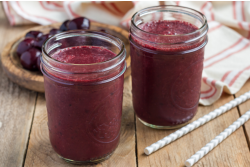We’ve made it through the summer holidays and now the next challenge is strengthening your child’s immune system for the return to school. A healthy diet is paramount to provide all the nutrients they need to ensure a robust immune system. If you’re not sure which nutrients are important, or what to do if and when your children get poorly, we’ve gathered our top nutritional and lifestyle tips all in one place, so read on to learn more!
Throughout their early years, our children are constantly developing their immune system, which needs to learn to adapt to the outside world, in order to equip them with a functioning immune response in adulthood. An undeveloped immune system is one of the reasons why children are very prone to infections, in particular upper respiratory tract infections (URTIs), including otitis media (glue ear), tonsillitis, bronchitis, and the common cold.
KEY NUTRIENTS FOR IMMUNE SUPPORT
VITAMIN D
Vitamin D contributes to the normal function of the immune system. Vitamin D deficiency is common and has been linked to an increased risk of URTIs, such as tonsillitis in children,1 so ensuring adequate supply could be useful in preventing infection. The Department of Health recommends a daily supplement of 10mcg (400iu) for children from 6 months to 5 years of age. However, higher levels (1200iu) in school children have been shown to reduce the incidence of flu by 40%.2 In times of need, you can increase the level for a short period (approximately 1-2 weeks).
Vitamin D upper limits for short-term in children (as clinically necessary):
1-3years
4-8years
9-13years
Vitamin D
63mcg/2520IU
75mcg/3000IU
100mcg/4000IU
VITAMIN A
Vitamin A is a fat-soluble vitamin which is important in maintaining the barrier membranes in the body and can amplify the immune response when needed.3 Vitamin A may also be lost in substantial amounts in urine during an infection.4 In children, it has been found effective in managing measles infections5 and hand, foot and mouth disease.6
Vitamin A rich foods: meat, oily fish, eggs, butter. Fruit and vegetables: carrots, sweet potato, spinach, kale, Swiss chard, cantaloupe melon, and peppers, contain carotenoids which can be converted to active vitamin A in the body.
If your child is following a vegan or vegetarian diet, it is important to supplement with vitamin A in its active form (as retinol) to ensure adequate intake for immune health.
VITAMIN C
Vitamin C is another nutrient needed for normal function of immune system. Our germ-fighting white blood cells need vitamin C to perform their tasks efficiently and they accumulate it for times of viral and bacterial invasion. In children, supplemental vitamin C can decrease the duration and symptoms of respiratory tract infections,7 including pneumonia.8
Vitamin C rich foods include peppers, broccoli, spinach, strawberries, pineapple, oranges, kiwi fruit, cantaloupe, and cauliflower, and should be consumed raw or only lightly steamed to conserve their vitamin C content. Easy ways to do this include smoothies, fruit salads, or even fruit ‘kebabs’. Vegetables can often be trickier to increase, so finely chopping or grating them, making them into crudités, and adding to soups or sauces can often help.
A good daily dose of vitamin C for children from one year is 250mg, which can often be found in a good quality multivitamin. This can however be increased for a short period (1-2 weeks) when necessary whilst fighting infections (see table below). If using vitamin C in a powder form, it is really easy to add to a water bottle or beaker that the child can sip on throughout the day.
Vitamin C upper limits for short-term in children (as clinically necessary):
1-3years
4-8years
9-13years
Vitamin C
400mg
650mg
1200mg
ZINC
Zinc promotes immunity, tissue repair, and antioxidant function in the body. The main role of zinc in the immune system, is preventing the spread of to bacteria and virus by reducing their replication.9 It also maintains strong barrier membranes in the skin and respiratory tractto prevent microbial entry.9 Zinc-deficient individuals often experience increased susceptibility to a variety of pathogens.10
Zinc rich foods include seafood, beef and lamb, spinach, pumpkin seeds, cocoa, chicken, beans, mushrooms.
A good quality multinutrient will provide enough zinc for a daily dose, however for additional short-term immune support it can be increased.
Zinc upper limits for short-term in children (as clinically necessary):
1-3years
4-8years
9-13years
Zinc
7mg
12mg
23mg
ELDERBERRY
Elderberry has been traditionally used for its many health and nutritional benefits. It is rich in powerful anthocyanins which can strengthen the immune system. It is best used alongside other immune-supporting nutrients for short periods. Research shows elderberry extract supports immune function by enabling the immune cells to recognise and stop viral invaders, and it comes with a long history of safe and effective use. It’s been demonstrated that elderberry also has the potential to ‘blunt’ the spikes on the outside of certain viruses and stop them from entering the cells where they would otherwise replicate.11 Elderberry is therefore often best taken at first signs of infection to stop the virus entering the cells and multiplying, alongside the vitamins and minerals mentioned above which collectively help to strengthen and balance the immune system. Smaller amounts can also be used daily as an extra immune boost, especially for children with a weak immune system.
LIVE BACTERIA
Our gut friendly bacteria are essentially gate-keepers protecting us from invaders. They are essential for healthy development and resilience. Imbalances of gut bacteria, caused by antibiotics, insufficient fibre intake, toxins etc., can predispose us to infections. To support a healthy balance, use good-quality bacterial strains which have been used in clinical trials. Good examples for children include Lactobacillus acidophilus, Bifidobacterium lactis, Bifidobacterium bifidum, or Lactobacillus rhamnosus GG.
Probiotic can be found in foods like full fat yoghurt (including coconut yoghurt), kefir, sauerkraut, miso, tempeh and sourdough bread. A great dessert or snack option could be natural yoghurt with a homemade fruit compote (berries for extra vitamin C or stewed apples for fibre). Kefir can be added to a simple smoothie – strawberry, banana, and kefir. Miso paste can be added to soups, spread onto salmon or chicken before baking, or mixed with some oil and apple cider vinegar and drizzled onto salad or roasted veggies.
A great strategy for supporting immunity in children would be a comprehensive children’s multinutrient formula which includes a range of immune-supporting nutrients such as vitamin A and zinc. It would also provide assurance of optimal daily nutrient intake, especially if children are fussy-eaters or have varying appetites. Alongside a multinutrient, a probiotic would be worth considering, as well as extra vitamin C and elderberry, when needing additional support
If your children do pick up an infection, here’s what you can do to help:
- Remember a fever is the body’s natural process of dealing with an infection. The raised body temperature can kill off bacteria and viruses that are sensitive to temperature changes. A low-grade fever is a body temperature of over 38oC (100.4oF), and above 39oC (102.2oF) is a high- grade fever. If there is a prolonged fever or you have any concerns at all, do not hesitate to call 111 or speak to your doctor/pharmacist.
- Natural ways to support a fever include ensuring they are well hydrated (water, coconut water, homemade ice lollies with water and some fruit), get plenty of rest, give them a bath with lukewarm water, and open a window to keep air circulating.
- A traditional remedy used to ‘draw out’ a fever is a washcloth soaked in diluted apple cider vinegar (1 part vinegar to 2 parts water) then placed on the forehead or the abdomen.
- For older children with a sore throat, they can also gargle with salt water, or use Manuka honey with lemon to relieve irritation.
And try to remember to:
- Prioritise sleep with restricted access to electronic devices close to bedtime. Children may try to persuade you to let them stay up late if they don’t have school in the morning. However, it is important to try to stick to regular sleep routines and practice good sleep hygiene. Try to limit screen time 2-3 hours before bedtime as electromagnetic radiation and bright screens can contribute to poor sleep quality which can then negatively affect immune function.
- Minimise/avoid foods containing wheat, dairy, and refined sugar as they can reduce immune function.12 Focus on nutrient dense food to ensure they are getting enough immune supporting micronutrients and antioxidants – eat the rainbow! Get your child a cool bento box for lunch with divided sections to offer a variety of foods. This can include:
- Homemade pancakes spread with nut butters, cream cheese or sprinkled with cheese, cucumber and peppers and then rolled.
- Apple crisps, olives, pieces of chicken or turkey, gherkins or capers, homemade salmon pate (cream cheese and tinned or freshly cooked salmon with lemon juice) spread on oatcakes, crackers or served with breadsticks.
- Instead of that soggy ‘empty nutrient’ sandwich, try spelt pasta salad made with roast veg sauce and drizzled with basil pesto.
Don’t be afraid to experiment, you will be surprised by your child’s ability to try new flavours. Be inspired by colour, variety and the seasons. Some great books to get you started are Natasha Corrett’s Family Kitchen and Lucinda Miller’s The Good Stuff.
- Don’t be afraid to take the children outside – This is really important for their physical and mental wellbeing, as children of every age can feel the pressure and consequent stress of a new school year, particularly given the current global situation. Studies have shown that children living in a loving and nourishing environment have a better stress response which carries them through into adulthood.13 Days out, going to the park, reading their favourite book, and helping them with their homework, are all great ways of showing love and dedication to them.
We hope that this article has inspired you with some practical tips about how to support your children’s immune health as they head back into school. If you need further tailored advice, please do not hesitate to contact our Nutrition Team or seek the advice of a Registered Nutritional Therapist or other healthcare practitioner.
References
1. Yildiz I, Unuvar E, Zeybek U, et al. The role of vitamin D in children with recurrent Tonsillopharyngitis. Ital J Pediatr. 2012;38(1):25. doi:10.1186/1824-7288-38-25
2. Urashima M, Segawa T, Okazaki M, Kurihara M, Wada Y, Ida H. Randomized trial of vitamin D supplementation to prevent seasonal influenza A in schoolchildren. American Journal of Clinical Nutrition. 2010;91(5):1255-1260. doi:10.3945/ajcn.2009.29094
3. Hall JA, Grainger JR, Spencer SP, Belkaid Y. The role of retinoic acid in tolerance and immunity. Immunity. 2011;35(1):13-22. doi:10.1016/j.immuni.2011.07.002
4. Stephensen CB, Alvarez JO, Kohatsu J, Hardmeier R, Kennedy JI, Gammon RB. Vitamin A is excreted in the urine during acute infection. American Journal of Clinical Nutrition. 1994;60(3):388-392. doi:10.1093/ajcn/60.3.388
5. Huiming Y, Chaomin W, Meng M. Vitamin A for treating measles in children. In: Cochrane Database of Systematic Reviews. Vol 2005. John Wiley & Sons, Ltd; 2005. doi:10.1002/14651858.cd001479.pub3
6. Chen S, Yang Y, Yan X, Chen J, Yu H, Wang W. Influence of vitamin A status on the antiviral immunity of children with hand, foot and mouth disease. Clinical Nutrition. 2012;31(4):543-548. doi:10.1016/j.clnu.2011.12.005
7. Vorilhon P, Arpajou B, Vaillant Roussel H, Merlin É, Pereira B, Cabaillot A. Efficacy of vitamin C for the prevention and treatment of upper respiratory tract infection. A meta-analysis in children. Eur J Clin Pharmacol. 2019;75(3):303-311. doi:10.1007/s00228-018-2601-7
8. Khan IM, Shabbier A, Naeemullah S, et al. Efficacy of Vitamin C in Reducing Duration of Severe Pneumonia in Children. Vol 18.; 2014.
9. Cunningham-Rundles S, McNeeley DF, Moon A. Mechanisms of nutrient modulation of the immune response. Journal of Allergy and Clinical Immunology. 2005;115(6):1119-1128. doi:10.1016/j.jaci.2005.04.036
10. Gammoh NZ, Rink L. Zinc in infection and inflammation. Nutrients. 2017;9(6). doi:10.3390/nu9060624
11. Weng JR, Lin CS, Lai HC, et al. Antiviral activity of Sambucus FormosanaNakai ethanol extract and related phenolic acid constituents against human coronavirus NL63. Virus Research. 2019;273:197767. doi:10.1016/j.virusres.2019.197767
12. Childs CE, Calder PC, Miles EA. Diet and immune function. Nutrients. 2019;11(8). doi:10.3390/nu11081933
13. Thompson RA. Stress and child development. Future of Children. 2014;24(1):41-59. doi:10.1353/foc.2014.0004






